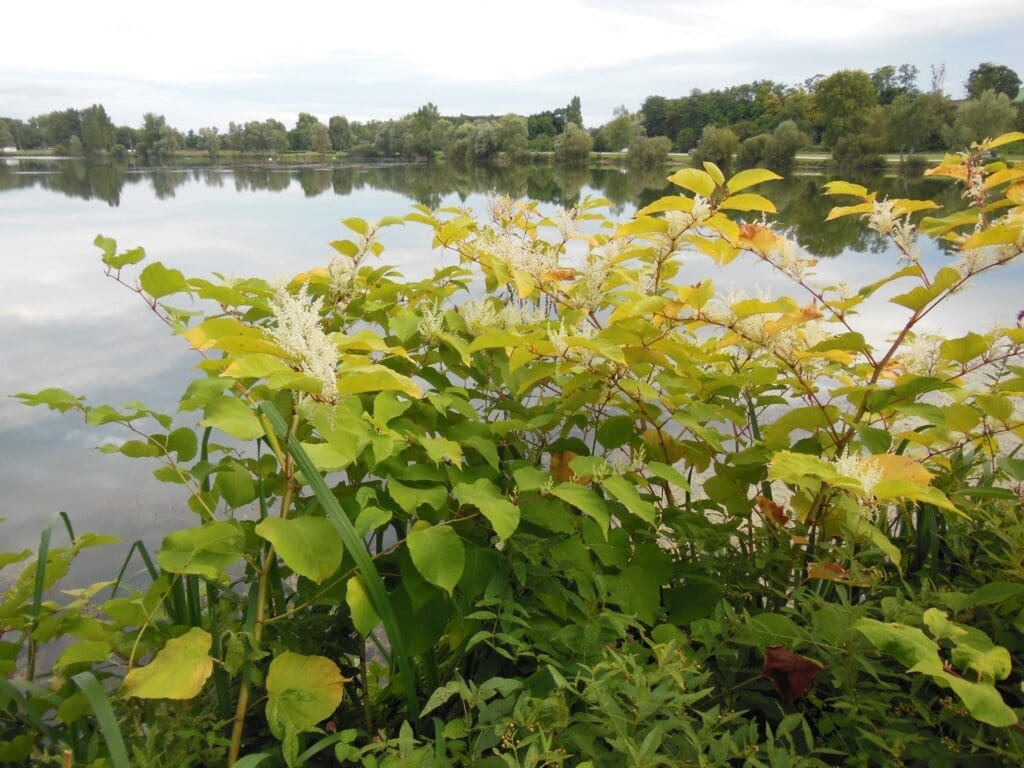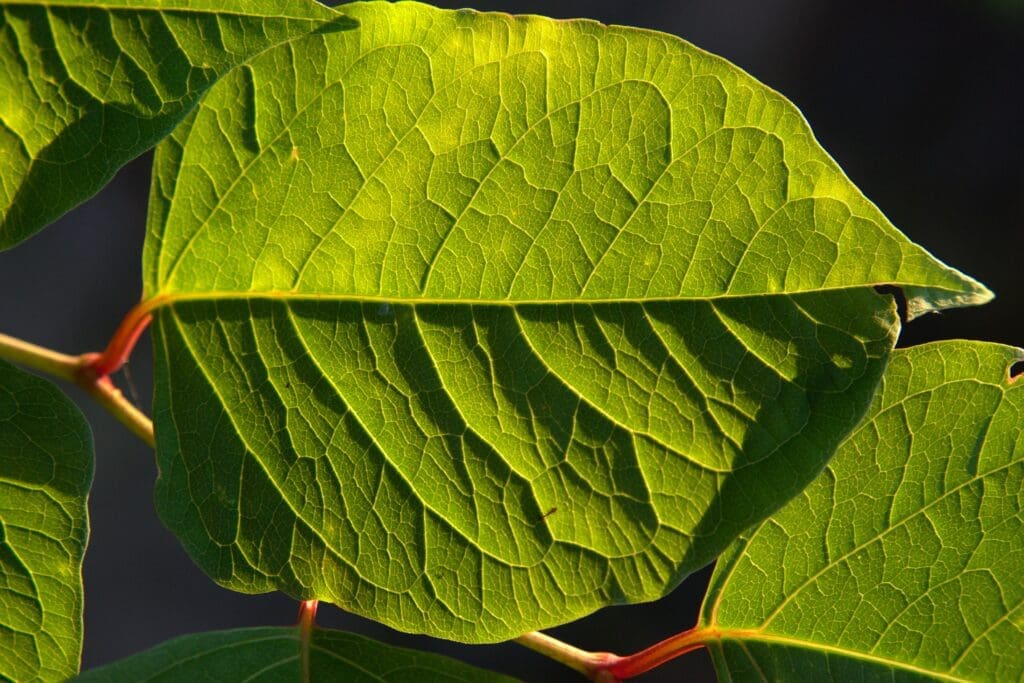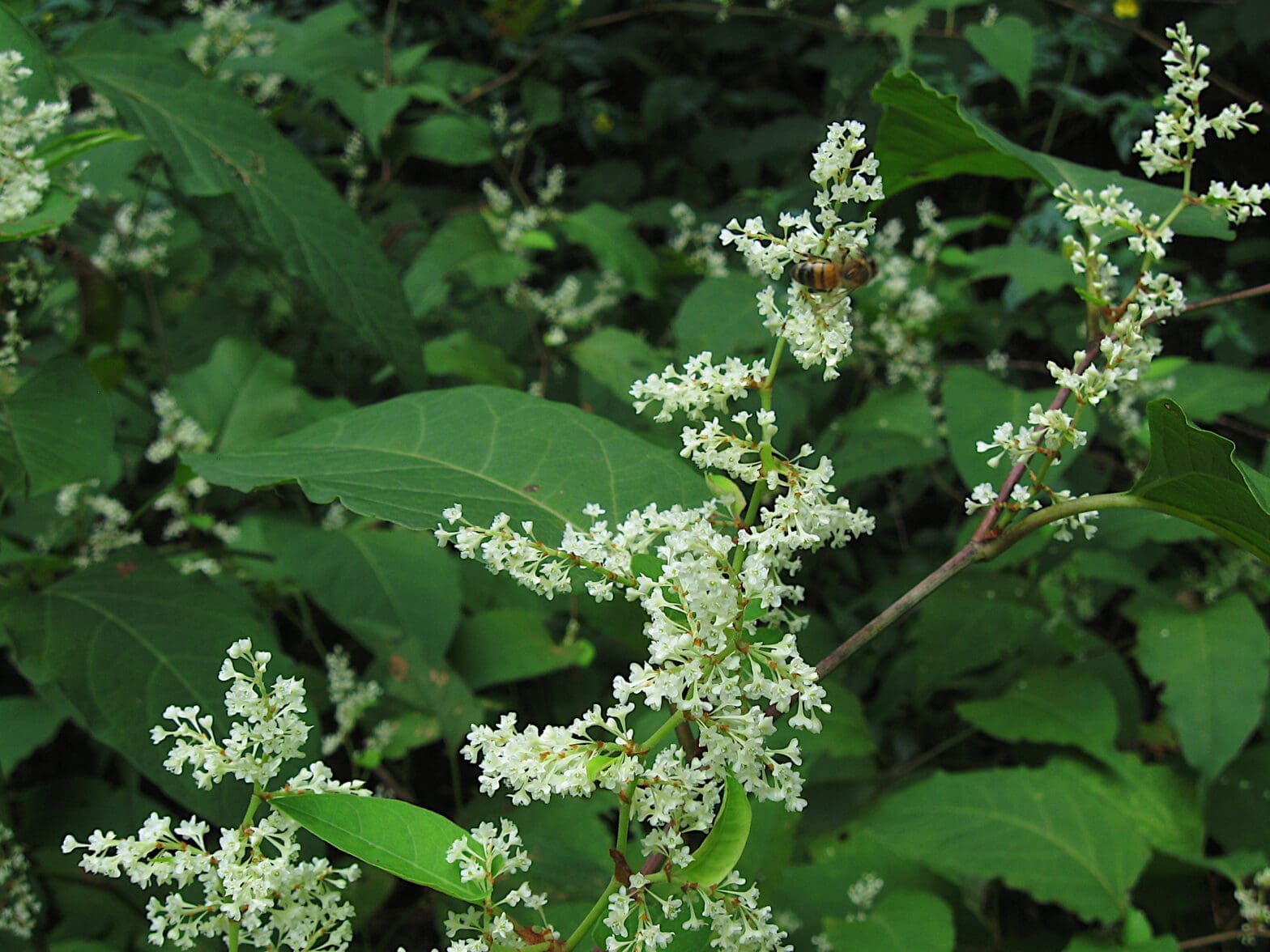With leaves shaped like a spade, what plant
is known to invade and refuses to fade?
The Japanese knotweed (Reynoutria japonica)

On a warm spring afternoon, my friend and I explored a creek off the Mill River, in Northampton Massachusetts. Thick green bushes lined the banks, making it difficult to reach the water’s edge. As we scoped for a route through, my friend pulled on a nearby branch, inspecting its leaf.
“Japanese Knotweed,” she identified, grasping the plant at the thick part of its stem and straining to pull it up . “This was my whole summer.”
She’d worked on a farm the previous summer and spent countless hours eradicating weeds, which, as it turned out, were mostly Japanese knotweed.
I too am familiar with knotweed. As a child, I mistook Japanese knotweed’s hollow stems for bamboo, often wielding them as makeshift swords. At the time, I thought of the plant as little more than a plaything, unaware of the complex role it was playing in the ecosystem around me.




Photos courtesy Jim Laurie
Where does Japanese knotweed grow?
Japanese knotweed is native to East Asia in Japan, China, and parts of Korea and Taiwan. The plant was introduced to North America in the late nineteenth century, to be used as an ornamental plant. Its introduction, however, had unintended consequences as it invaded wetland, stream corridors, forest edges, and drainage ditches. Japanese knotweed is a herbaceous perennial plant (a non-woody plant that regrows each year from its roots), that can grow to be up to 11 feet tall, with jointed hollow stems resembling that of, yes, bamboo. So you can forgive my childhood ignorance. The stems are bright green and grow nodes which can range in color from red to purple. The knotweed’s spade-shaped leaves grow from these nodes, with a square base and sharp point. They thrive in full sun but can also grow in partial shade, and do well in a variety of soil and moisture conditions. It can often be observed on the banks of rivers, wet depressions, and woodland edges, or in more built environments, including construction sites and roadways.
During the summer, from the nodes of the knotweed bloom small white and pale green flowers. These little flowers are 3 to 4 inches long, and grow in fingerlike clusters, with each cluster holding a couple dozen flowers.

While Japanese knotweed is known as an invasive species in many parts of the world, including throughout the United States, in its native range it plays a much different role. There, it exists in balance with local ecosystems, kept in check by native insects, fungi, and herbivores that have evolved alongside it. Instead of forming dense monocultures that crowd out other plants, knotweed grows as part of diverse plant communities, coexisting with a wide variety of species.
Unlike in North America and Europe, where few animals or insects consume it, knotweed supports a variety of wildlife in its natural habitat, and its nectar is enjoyed by bees and butterflies, especially in late summer when other flowers have faded. Insects such as the aphid Aphalara itadori and various beetle species naturally feed on knotweed, limiting its dominance and allowing native plants to thrive alongside it. Some fungi, like Mycosphaerella leaf spot, help regulate its growth, preventing the unchecked spread seen in non-native environments. These interactions ensure that Japanese knotweed remains just one part of a broader ecosystem rather than an overwhelming force.
Ecologically, Japanese knotweed plays an important role in nutrient cycling and soil formation. Its deep, extensive rhizome network helps stabilize slopes prone to erosion in Japan’s more volcanic landscapes, helping to prevent landslides and maintaining soil structure. Additionally, the plant’s decomposition contributes to organic matter in the soil, enriching the surrounding environment.
But when introduced elsewhere, many of these ecological checks and balances are missing, allowing knotweed to spread aggressively and disrupt local biodiversity.
How does it spread?
Japanese knotweed reproduces through both seeds and rhizomes, an underground root-like system which produces shoots of new plants, coming up through the earth. As much as two-thirds of the plant’s biomass is stored in this network.

The knotweed can be found around the world, far from home. It was introduced to the United Kingdom in 1825 and has since spread across Europe. The majority of Japanese knotweed populations in Europe descend from a single female genotype, though hybridization with related species has introduced some genetic variation. This female genotype is able to receive pollen from a close relative, called the giant knotweed. The combination of these two plants produces a hybrid known as the Bohemian knotweed, which is also spreading across Europe.
In North America, however, the Japanese knotweed reproduces differently than its European counterpart. Even though the European female clone is widely dispersed around the United States, this clone is not the only genotype present. Populations of both male and female Japanese knotweed have been identified across America. The female Japanese knotweed does not produce pollen and primarily spreads through those rhizomes, though it can also reproduce via seeds when pollinated by a related species. Male Japanese knotweed, on the other hand, do produce pollen, as well as occasionally producing seeds.
Impact
Japanese knotweed grows in thick clusters, emerging during early spring time and growing quickly and aggressively. This dense stand of plants crowds out native vegetation, depriving them of resources needed for reproduction and survival.

Japanese knotweed thrives in moist, shaded environments. On stream banks, it outcompetes native grasses and shrubs, reducing biodiversity. This lack of diversity along the bank causes instability, and makes it more likely that the soil will shear off during flooding, increasing the amount of sediment deposited into the water. This erosion sends soil and Japanese knotweed seeds into the creek, allowing the plant to spread downstream and further destabilizing the stream bank.
Foraging Japanese knotweed
The young, spring shoots of Japanese knotweed are not only edible, but also delicious! The plant has a tart, slightly sweet taste, similar to that of rhubarb. It can be turned into a jam, put in salads or a stir fry, and used as a crunchy addition to sushi. Where it is native in East Asia, knotweed has been used in traditional medicine for hundreds of years. Owing to the plant’s invasive nature, practicing responsible foraging is crucial to avoid accidentally spreading the knotweed populations. In order to properly dispose of the leftover plant matter, it must be boiled, burned, or thoroughly dried out before discarding in order to ensure that no knotweed is spread. Foraging and eating Japanese knotweed can be a way to help control the plant, through the repeated cutting of the stems. The following video shows a recipe for homemade Japanese knotweed pickles!
Managing knotweed
Due to its dense clusters and deep root system, once established, Japanese knotweed is incredibly difficult to remove. Manually, populations can be managed through repeated cutting, though complete removal of rhizomes is extremely difficult and can sometimes lead to further spread of the knotweed. When it comes to cutting, the stems of the plant must be cut three separate times during the growing season in order for this to be an effective treatment. In terms of digging up the roots, this can be very labor intensive, and the process of digging Japanese knotweed can unintentionally cause the spread of rhizome fragments, which can result in even more Japanese knotweed on your hands!

Through dedicated work, such as that of my friend who spent three months eradicating Japanese knotweed on her farm, the populations and impacts of the plant, when invasive, can be mitigated. With a little time and effort, you can help control knotweed in your own backyard…and maybe even harvest some for dinner.

Helena is a student at Smith College pursuing psychology, education, and environmental studies. She is particularly interested in conversation psychology and the reciprocal relationship between people and nature. Helena is passionate about understanding how communities are impacted by climate change and what motivates people towards environmental action. In her free time, she loves to crochet, garden, drink tea, and tend to her houseplants.
Sources and Further Reading:
- Japanese Knotweed, Polygonum cuspidatum (Fallopia japonica), IPSAWG, Purdue
- Art Gover, et al., 2020
- Michigan Department of Natural Resources, Michigan Natural Features Inventory, 2012
- Invasive Plant Profile: Japanese Knotweed, National Park Service




